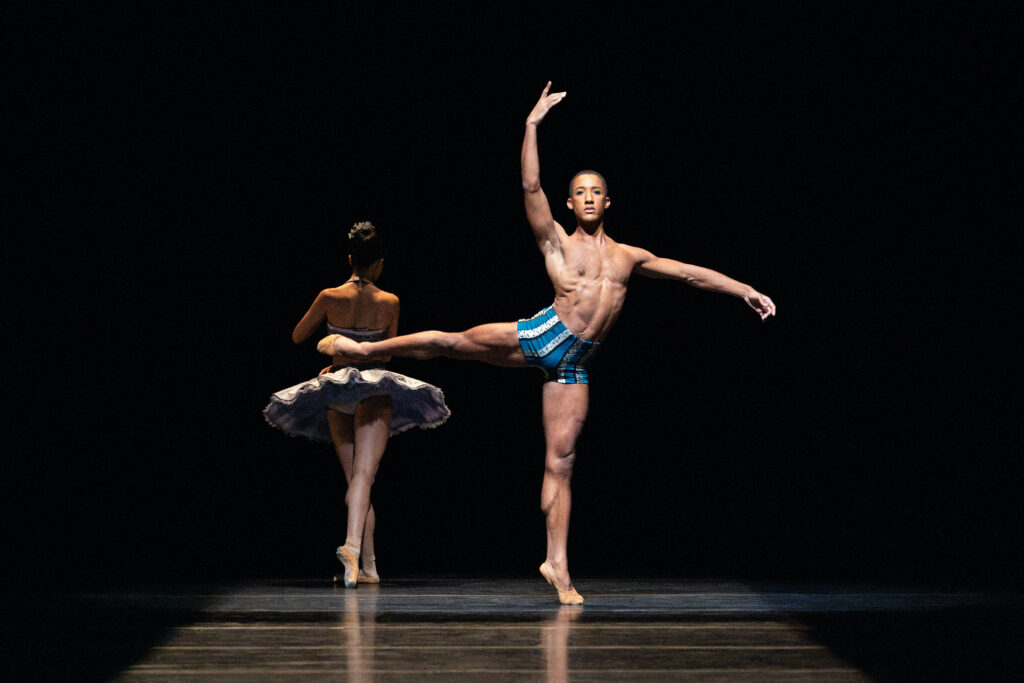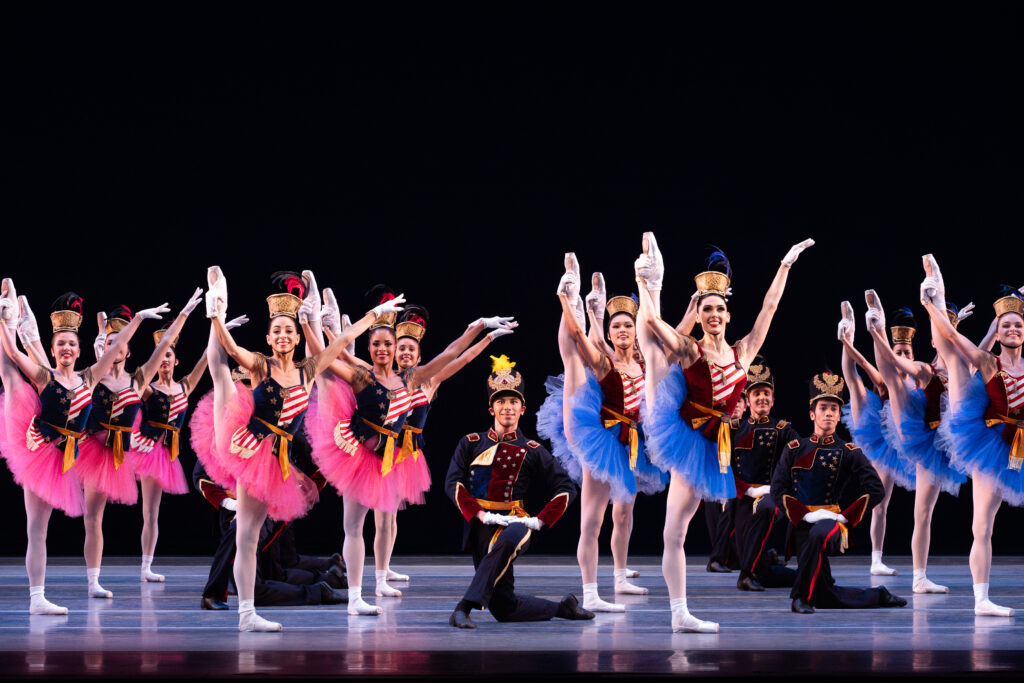
Stanton Welch’s Tu Tu Shines
Houston Ballet’s mixed rep program is a mixed bag.
A trio of wildly different one-acts make up the Houston Ballet’s mixed rep program Tu Tu.
Stanton Welch’s Tu Tu, which Houston audiences have seen before, opened the program. That was followed by Annabelle Lopez Ochoa’s Delmira, making its world premiere here, and George Balanchine’s Stars and Stripes, making its company premiere.
Welch, the openly gay Artistic Director of the Houston Ballet, created Tu Tu in 2003 for the San Francisco Ballet. Houston Ballet first performed the abstract work in 2007.
In keeping with its name, Tu Tu featured classical tutus for the women dancers. (The men appear in tight, tiny shorts.) The movement, however, included a less classical vocabulary with occasionally unpointed feet and sharper-than-usual elbows.

Photo by Lawrence Elizabeth Knox (2023). Courtesy of Houston Ballet.
An ensemble piece with 22 dancers, Tu Tu featured three couples. The spirited Gold Couple was first soloist Tyler Donatelli and corps de ballet member Eric Best. Principal dancer Yuriko Kajiya and first soloist Harper Watters were the understated and somber Blue Couple. (The Blue Couple had some especially nice pas de deux and solo moments.)
Soloists Aoi Fujiwara and Naazir Muhammad were the majestic and stately Red Couple. Muhammad continues to impress audiences with his complete command of the stage. In Tu Tu he partnered extremely well with Fujiwara. We hope to see more of him during the coming season.
Much of Tu Tu’s success was due to the score, Ravel’s Concerto for Piano in G major.
An exuberant mix of Basque folk melodies and American jazz, the score moved from spirited to hypnotic and back again. As always, Houston Ballet’s principal pianist Katherine Burkwall-Ciscon excelled in her performance.
Welch’s graceful, lyrical and sometimes humorous choreography paired wonderfully with the music. Tu Tu unexpectedly proved to be the most enjoyable work of the program.
Lisa J. Pinkham, an out lesbian, designed the lighting for Tu Tu while Holly Hynes designed the costumes.
The program’s most anticipated work was Annabelle Lopez Ochoa’s Delmira.
It chronicles the life of 20th-century poet Delmira Agustini. A ground-breaking poet in Uruguay, she freely wrote about women’s sensuality. At the same time, the rigid, sexist norms of her era stifled her personal life.
Delmira picks up the action when a young Agustini is carrying on a happy affair with free-spirited Argentinian writer Manuel Ugarte. Unfortunately, the affair doesn’t stop her family from forcing her into a marriage with conservative businessman Enrique Reyes. She left him within weeks. Tragically, that relationship ended in a scandalous murder-suicide a year later.
Delmira had all the elements of a winning production.
It had an excellent cast and a dramatic plot involving love, lust, desire, and death. It was set to a superb tango-infused score by Juan Pablo Acosta. Katherine Burkwall-Ciscon not only provided a sweeping arrangement, her nimble performance added to the production. And there was a spectacular set by Christopher Ash.
Houston Ballet principal dancer Melody Mennite was strong and expressive as Delmira. Demi soloist Syvert Lorenz Garcia was dashing, even raffish as her lover. He was the perfect counterpoint to principal Connor Walsh’s restraint and severity.
But as a 37-minute one-act, Delmira is a story only half-told. There’s much more to Agustini’s life to explore; her legacy deserves more of our time and attention.

Photo by Lawrence Elizabeth Knox (2023). Courtesy of Houston Ballet.
Closing out the program is George Balanchine’s Stars and Stripes. He created the piece in 1958. It was a much different time. Patriotism was high. The New York City Ballet, in its infancy, was nonetheless flourishing. And Balanchine, a Russian immigrant, was eager to honor his adopted country.
Set to marches by John Philip Sousa, Stars and Stripes was something of “a musical joke.” (That’s what Lincoln Kirstein, co-founder of the New York City Ballet, called it at the time.)
Seen in that spirit, Stars and Stripes was a delightful time capsule.
The production was reminiscent of a Rockette performance. Dozens of dancers marched on pointe in intricate configurations and performed high kicks, bits of the can can, along with endless turns and jumps. There was even a baton-twirling majorette.
The piece requires a huge and good-humored cast. Houston Ballet’s especially talented and proficient corps de ballet delivered an enthusiastic performance while wearing genuine smiles.
What: Houston Ballet presents Tu Tu
Where: Wortham Theater Center, 501 Texas Avenue
When: Through October 1
Info: For tickets, visit houstonballet.org or call 713-227-2787.










